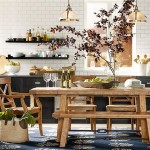How To Decorate In A Small Space
Decorating a small space can be challenging. Maximizing functionality while maintaining a sense of spaciousness requires careful planning and creative solutions. This article will provide practical strategies for effectively decorating a small living area.
Embrace Minimalism: A minimalist approach is often the most effective strategy for small spaces. Clutter can quickly overwhelm a limited area, making it feel cramped and disorganized. Prioritize essential furniture pieces and decorative items. Consider multi-functional furniture, such as ottomans with storage or sofa beds, to maximize space utilization.
Strategic Furniture Placement: Careful furniture placement is crucial in a small space. Avoid pushing furniture against walls, which can actually make the room feel smaller. Instead, consider floating furniture away from the walls to create a sense of airiness. Utilize vertical space with tall bookshelves or wall-mounted storage units to draw the eye upward and create the illusion of height. Choose furniture with a smaller footprint, like sleek chairs and narrow tables.
Light and Bright Color Palette: Light colors reflect more light, making a space feel larger and more open. Opt for a neutral color palette for walls, ceilings, and larger furniture pieces. Whites, creams, and pale pastels are excellent choices. Introduce pops of color through smaller accessories, textiles, and artwork to add personality and visual interest without overwhelming the space.
Maximize Natural Light: Natural light is a powerful tool for enhancing the perception of space. Keep window treatments minimal, opting for sheer curtains or blinds that allow light to filter through. Avoid heavy drapes or dark blinds that can block natural light and make the room feel closed in. Strategically placed mirrors can also help reflect natural light and amplify its effect.
Creative Storage Solutions: Efficient storage is essential in a small space. Utilize every available nook and cranny with clever storage solutions. Under-bed storage containers, wall-mounted shelves, and vertical storage units can help keep belongings organized and out of sight. Consider incorporating furniture with built-in storage, such as ottomans with hidden compartments or beds with drawers underneath.
Mirrors and Reflective Surfaces: Mirrors are a classic design trick for creating the illusion of more space. Strategically placed mirrors can reflect light and visually expand a room. Consider placing a large mirror opposite a window to maximize natural light reflection. Incorporating other reflective surfaces, such as glass tabletops or metallic accents, can also contribute to a sense of spaciousness.
Vertical Lines and Stripes: Vertical lines and stripes can create the illusion of height in a small room. Consider incorporating vertical stripes in wallpaper, curtains, or rugs. Tall, slender furniture pieces and vertical artwork can also contribute to this effect, drawing the eye upward and making the ceiling appear higher.
Multi-Functional Furniture: Multi-functional furniture pieces are invaluable in a small space. A sofa bed can serve as both seating and a guest bed, while a coffee table with storage can keep clutter at bay. Look for furniture that can serve multiple purposes to maximize functionality and minimize the need for numerous individual pieces.
Scale and Proportion: Choosing furniture and decor that is appropriately scaled to the room is crucial. Oversized furniture can easily overwhelm a small space, making it feel cramped. Opt for furniture with a smaller footprint and avoid overly large or bulky pieces. Maintain a sense of proportion between furniture and the room's dimensions to create a balanced and harmonious look.
Textiles and Textures: Textiles and textures can add warmth, personality, and visual interest to a small space without overwhelming it. Use throws, pillows, and rugs to introduce texture and color. Choose lightweight fabrics and avoid heavy or overly patterned textiles that can make the room feel cluttered. Consider using a single rug to define the seating area and anchor the space.
Decluttering Regularly: Regular decluttering is essential for maintaining a sense of spaciousness in a small living area. Periodically assess belongings and remove any items that are no longer needed or used. A clutter-free environment will contribute significantly to a feeling of openness and tranquility.
Personal Touches: While minimalism is recommended for small spaces, it's important to inject personality and warmth. Incorporate personal touches through artwork, photographs, and decorative accessories. These elements can add character and make the space feel more inviting without overwhelming the limited area. Choose a few carefully curated items that reflect personal style and interests.
Greenery and Plants: Introducing greenery can bring life and freshness to a small space. Plants add a touch of nature and can help purify the air. Choose plants that thrive in indoor environments and are appropriate for the available light conditions. Vertical planters or hanging baskets can be a great way to incorporate greenery without taking up valuable floor space.
:strip_icc()/cdn.cliqueinc.com__cache__posts__215607__how-to-decorate-a-small-space-215607-1536685792481-main.700x0c-2c1e565de78346d698e1866d2a5fc871.jpg?strip=all)
Now This Is How To Decorate A Small Space
Experts Share Biggest Mistake People Make When Decorating Small Spaces

How To Decorate A Small Space Centris Ca

17 Tips Tricks For Small Space Living

50 Smart Design Ideas For Small Spaces

6 Practical Small Space Decorating Ideas Saving Solutions
:max_bytes(150000):strip_icc()/236608877_287634333162970_6363336183903051726_n-63ab3e1976184317bdc51527a780339c.jpg?strip=all)
45 Small Living Room Ideas For Maximum Space And Style

8 Small Space Decorating Rules To Break Now

25 Small Space And Furniture Ideas For Your Home

17 Small Living Room Ideas To Maximize Your Space Spacejoy







